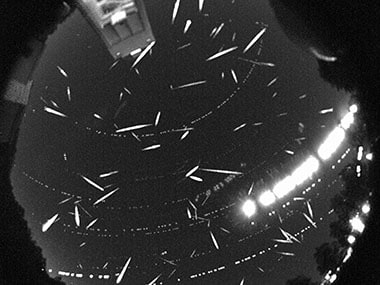Sky gazers across the country can watch a meteor shower display from tomorrow night till the early hours of 14 December, if clouds and light pollution do not play spoilsport. The Geminid meteor shower is expected to provide a celestial display and people will have to move out of the glare of city lights to a darker region, Director, M P Birla Planetarium, Debiprosad Duari said. [caption id=“attachment_4256159” align=“alignleft” width=“380”]  The Geminid shower imaged in 2010. Image: NASA.[/caption] Sky watchers should go to an open space and keep an eye on the sky and binoculars or telescopes will not be required to watch the celestial display, Duari said. “This year the Geminid meteor shower is predicted to peak on the night of 13 December and the early morning of 14 December. The shower will start at around 10 pm on 13 December when the Gemini constellation will be visible in the north-eastern sky, a little above and right of the familiar Orion constellation,” Duari said. The shower is predicted to be at its maximum at around 2 am on 14 December, when the Gemini constellation will be almost overhead and the number of meteors can reach up to 120 per hour, he said. “Though the meteors tend to originate from the Gemini constellation, they can be observed from most parts of the sky. Since the meteors are relatively slow moving, the bright streaks of light will be easily visible and one does not need a binocular or telescope for enjoying the show while lying on an open ground away from city lights,” he said. Rocks and dust particles from space which are about to collide with Earths atmosphere are called meteoroids. He said, “And those that streak through the atmosphere are called meteors. Generally, comets, which are chunks of ice having lots of dust come close to the Sun. By the Sun’s radiation, the ice melts and the dust and rocks are left behind along the orbit of the comet. “If the Earth, in its yearly motion around the Sun happens to pass through such a trail of debris of dust particles, the small dust particles enter the Earth’s atmosphere with considerable speed.” By friction in the atmosphere, the particles then burn up and give rise to not only a single bright streak in the sky but numerous meteors called meteor showers, Duari elaborated. In case of the Geminid meteor shower, so named as the meteors appear to originate from the constellation of Gemini, it is not a comet but an unusual asteroid called 3200 Phaethon, discovered in 1983, the eminent scientist said. Generally the meteor shower associated with 3200 Phaethon, a 5.1 km piece of rock, peaks around second week of December and some astronomers believe the asteroid may have undergone a collision with another object in the distant past to produce the stream of particles that Earth runs into, creating the meteor shower.
Recently, researchers used **computer simulations** to understand exactly why meteoroids blow up in the Earth’s atmosphere. The fiery explosions occour because of a build up of a high pressure area in front of the meteor, but a relatively vacant almost vacuum of air behind it. The finding helped demonstrate that the atmosphere of the Earth is a much better shield against meteor impacts than previously thought. If there is no pollution or clouds, then the Moon will not play a spoilsport for this year’s Geminid shower. The Geminid shower is expected to be the best meteor shower in the year for this reason, as the Moon will be a thin and wispy crescent. Bill Cooke from **NASA's** Meteoroid Environment Office says, “With August’s Perseids obscured by bright moonlight, the Geminids will be the best shower this year. The thin, waning crescent Moon won’t spoil the show.” For maximum visibility, it is advisable to go out of the city to a remote location, preferably at an altitude. Taking along mats to lie down on will also help for long observation periods in a comfortable position. For those intending to capture the shower with photographs, a tripod is absolutely essential. A series of long exposures can be superimposed on one another to produce a final image of the shower. With inputs from PTI


)



